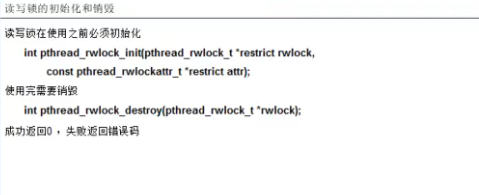线程同步:
1,进程同步的方法
2,互斥量,读写锁,条件变量的区别
3,合理同步,避免死锁
<1>互斥量
1)为什么要使用互斥变量?
例子1:不加互斥量条件下,同一个共享变量(资源)在不同线程间苯调用,其值无法保证。导致结果不一;如下例全局共享变量变量i被线程1和线程2交叉调用会导致不同的输出结果;
#include"stdio.h"
#include"unistd.h"
#include"sys/types.h"
#include"pthread.h"
#include"stdlib.h"
#include"string.h"
typedef struct Mutex{
int mux_1;
int mux_2;
}Mutex;
int i;//全局共享变量
Mutex Mt;//互斥变量
void *pthread_fun1(void *arg)
{
while(1)
{
Mt.mux_1=i;
Mt.mux_2=i;
if(Mt.mux_1 !=Mt.mux_2)
{
printf("%s Mt.mux_1=%d Mt.mux_2=%d\n",arg,Mt.mux_1,Mt.mux_2);
break;
}
++i;
}
return (void*)1;
}
void *pthread_fun2(void *arg)
{
while(1)
{
Mt.mux_1=i;
Mt.mux_2=i;
if(Mt.mux_1 !=Mt.mux_2)
{
printf(" %s Mt.mux_1=%d Mt.mux_2=%d\n",arg,Mt.mux_1,Mt.mux_2);
break;
}
++i;
}
return (void*)1;
}
int main()
{
pthread_t tid1,tid2;
int err1,err2;
int ini_mux;
err1=pthread_create(&tid1,NULL,pthread_fun1,"thread1");
if(err1 !=0)
{
printf("create new thread1\n");
return -1;
}
err2=pthread_create(&tid2,NULL,pthread_fun2,"thread2");
if(err2 !=0)
{
printf("create new thread2\n");
return -2;
}
pthread_join(tid1,NULL);//等待新线程执行完
pthread_join(tid2,NULL);//等待新线程执行完
return 0;
}
输出结果如图:
没有设置互斥量的i(共享资源)的值在任意不同线程的调用中会发生值的随机改变。
2)互斥锁的初始化和销毁。
3)加锁和解锁
4)互斥锁实例
例子2:基于例子1的情况下,为共享资源i建立互斥量,确保i在某个线程调用时不会被其他线程抢占调用。建立文件pthread_mutex_t.c;内容如下
#include"stdio.h"
#include"unistd.h"
#include"sys/types.h"
#include"pthread.h"
#include"stdlib.h"
#include"string.h"
typedef struct Mutex{
int mux_1;
int mux_2;
}Mutex;
int i;//全局共享变量
Mutex Mt;//结构体对象
pthread_mutex_t mutex;//互斥量
void *pthread_fun1(void *arg)
{
while(1)
{
pthread_mutex_lock(mutex);//p操作锁住i资源,确保线程用完前不被抢占
Mt.mux_1=i;
Mt.mux_2=i;
if(Mt.mux_1 != Mt.mux_2)
{
printf("%s Mt.mux_1=%d Mt.mux_2=%d\n",arg,Mt.mux_1,Mt.mux_2);
}
++i;
pthread_mutex_unlock(mutex);//解锁释放i资源,确保其他线程可以用
}
return (void*)1;
}
void *pthread_fun2(void *arg)
{
pthread_mutex_lock(mutex);
while(1)
{
pthread_mutex_lock(mutex);//p操作锁住i资源,确保线程用完前不被抢占
Mt.mux_1=i;
Mt.mux_2=i;
if(Mt.mux_1 != Mt.mux_2)
{
printf(" %s Mt.mux_1=%d Mt.mux_2=%d\n",arg,Mt.mux_1,Mt.mux_2);
}
++i;
pthread_mutex_unlock(mutex);//解锁释放i资源,确保其他线程可以用
}
}
return (void*)1;
}
int main()
{
pthread_t tid1,tid2;
int err1,err2;
int ini_mux;
//初始化互斥量,这样互斥量才可用
ini_mux=pthread_mutex_init(metux);
if(ini_mux !=0)
{
printf(" inital mutex failure\n");
return ini_mux;
}
err1=pthread_create(&tid1,NULL,pthread_fun1,"thread1");
if(err1 !=0)
{
printf("create new thread1\n");
return -1;
}
err2=pthread_create(&tid2,NULL,pthread_fun2,"thread2");
if(err2 !=0)
{
printf("create new thread2\n");
return -2;
}
pthread_join(tid1,NULL);//等待新线程的执行结束
pthread_join(tid2,NULL);//等待新线程的执行结束
return 0;
}
运行结果如下:
如图没有打印出数据,说在设置了互斥量metux后i资源就不会在某个线程调用时被其他线程抢占调用了,从而mux_1!=mux_2这个条件永远不成立。就不会打印结果。
5)死锁的解剖




<2>读写锁(读者与写者问题)
1)什么是读写锁,它与互斥锁的区别
2)读写锁的初始化和销毁:
3)枷锁和解锁:
4)读写锁实例:
例子3:验证一个共享资源可以被多个线程同时读加锁进行读取,即同时进行多个读加锁。
#include"stdio.h"
#include"unistd.h"
#include"sys/types.h"
#include"pthread.h"
#include"stdlib.h"
#include"string.h"
pthread_rwlock_t rwlock;//全局读写锁对象
void *pthread_fun1(void *arg)
{
pthread_rwlock_rdlock(&rwlock);//加读模式锁
printf("new thread 1\n");//打印
sleep(5);//睡眠5秒让出cpu
printf("here is thread 1 exit\n");
pthread_rwlock_unlock(&rwlock);//解锁
return (void*)1;
}
void *pthread_fun2(void *arg)
{
pthread_rwlock_rdlock(&rwlock);//加读模式锁
printf(" new thread 2\n");
sleep(5);//睡眠5秒让出cpu
printf("here is thread 2 exit\n");
pthread_rwlock_unlock(&rwlock);//解锁
return (void*)1;
}
int main()
{
pthread_t tid1,tid2;
int err1,err2;
int er_lock;
er_lock=pthread_rwlock_init(&rwlock,NULL);//初始化
if(er_lock !=0)
{
printf("init rwlock failure\n");
return er_lock;
}
err1=pthread_create(&tid1,NULL,pthread_fun1,"thread1");
if(err1 !=0)
{
printf("create new thread1\n");
return -1;
}
err2=pthread_create(&tid2,NULL,pthread_fun2,"thread2");
if(err2 !=0)
{
printf("create new thread2\n");
return -2;
}
pthread_join(tid1,NULL);//等待新线程执行完
pthread_join(tid2,NULL);//等待新线程执行完
return 0;
}
运行结果如图:
如图new thread 2和new thread 1被同时打印出,证实了一个共享资源变量可以被多个线程同时进行读加锁模式。
例子4:基于例子3将新线程里的读加锁pthread_rwlock_rdlock改为写加锁pthread_rwlock_rdlock,在进行编译运行,结果如下:
如图线程2先读加锁然后写完解锁后,线程1才能进程写加锁然后开始写。
写加锁和读加锁是互斥的,写时不能读,读时不能写。
<3>条件变量(生成者和消费者问题)
1)条件变量的引入
2)条件变量的初始化和销毁
3)条件变量的使用
4)条件变量实例(生产者和消费者)
建立文件phtread_producer_consmer.c;内容如下
#include"stdio.h"
#include"unistd.h"
#include"sys/types.h"
#include"pthread.h"
#include"stdlib.h"
#include"string.h"
#define BUFFER_SIZE 5 //产品库存大小
#define PRODUCT_CNT 30 //产品生产总数
typedef struct product_cons {
int buffer[BUFFER_SIZE];//生产产品
pthread_mutex_t lock;//互斥锁 volatile int
int readpos,writepos;//读写的位置
pthread_cond_t notempty;//条件变量,非空
pthread_cond_t notfull;//条件变量,非满
}Buffer;
Buffer buffer;//全局对象
void init(Buffer *p)
{
pthread_mutex_init(&p->lock,NULL);//初始化互斥锁
pthread_cond_init(&p->notempty,NULL);//初始化条件变量
pthread_cond_init(&p->notfull,NULL);//初始化条件变量
p->readpos =0;//初始化读位置
p->writepos =0;//初始化写位置
}
void finish(Buffer *p)
{
pthread_mutex_destroy(&p->lock);//销毁互斥锁
pthread_cond_destroy(&p->notempty);//销毁条件变量
pthread_cond_destroy(&p->notfull);//销毁条件变量
p->readpos =0;//读位置归零
p->writepos =0;//写位置归零
}
//存储一个数据到buffer
void put(Buffer *p,int data)//生产产品函数(入队)
{
pthread_mutex_lock(&p->lock);//写前加写模式锁
if((p->writepos+1)%BUFFER_SIZE==p->readpos)
{
printf("producer wait for not full\n");
pthread_cond_wait(&p->notfull,&p->lock);
}
p->writepos=(p->writepos+1)%BUFFER_SIZE;
p->buffer[p->writepos]=data;
pthread_cond_signal(&p->notempty);
pthread_mutex_unlock(&p->lock);
}
//读,从buffer中 移除一个数据
int get(Buffer *p)//消费产品函数(出队)
{
int data;
pthread_mutex_lock(&p->lock);//读取前加读模式锁
if(p->readpos == p->writepos)//队空
{
printf("consumer wait for not empty\n");
pthread_cond_wait(&p->notempty,&p->lock);
}
p->readpos=(p->readpos+1)%BUFFER_SIZE;
data = p->buffer[p->readpos];
pthread_cond_signal(&p->notfull);
pthread_mutex_unlock(&p->lock);
return data;;
}
void *producer(void *data)//子线程,生产者
{
int n;
for(n=1;n<=50;++n)//生产50个产品
{
sleep(1);
printf("producer put the %d product ... \n",n);
put(&buffer,n);
printf("producer put the %d product success\n",n);
}
printf("producer stopped");
return NULL;
}
void *consumer(void *data)
{
static int cnt =0;
int num;
while(1)
{
sleep(2);
printf("consumer get product ...\n");
num = get(&buffer);
printf("consumer get the %d product success\n",num);
if(++cnt == PRODUCT_CNT)
break;
}
printf("consumer stopped\n");
return NULL;
}
int main(int argc,char *argv[])
{
pthread_t th_a,th_b;
void *rval;
init(&buffer);
pthread_create(&th_a,NULL,producer,0);
pthread_create(&th_b,NULL,consumer,0);
pthread_join(th_a,&rval);
pthread_join(th_b,&rval);
finish(&buffer);
return 0;
}
运行结果如下:
